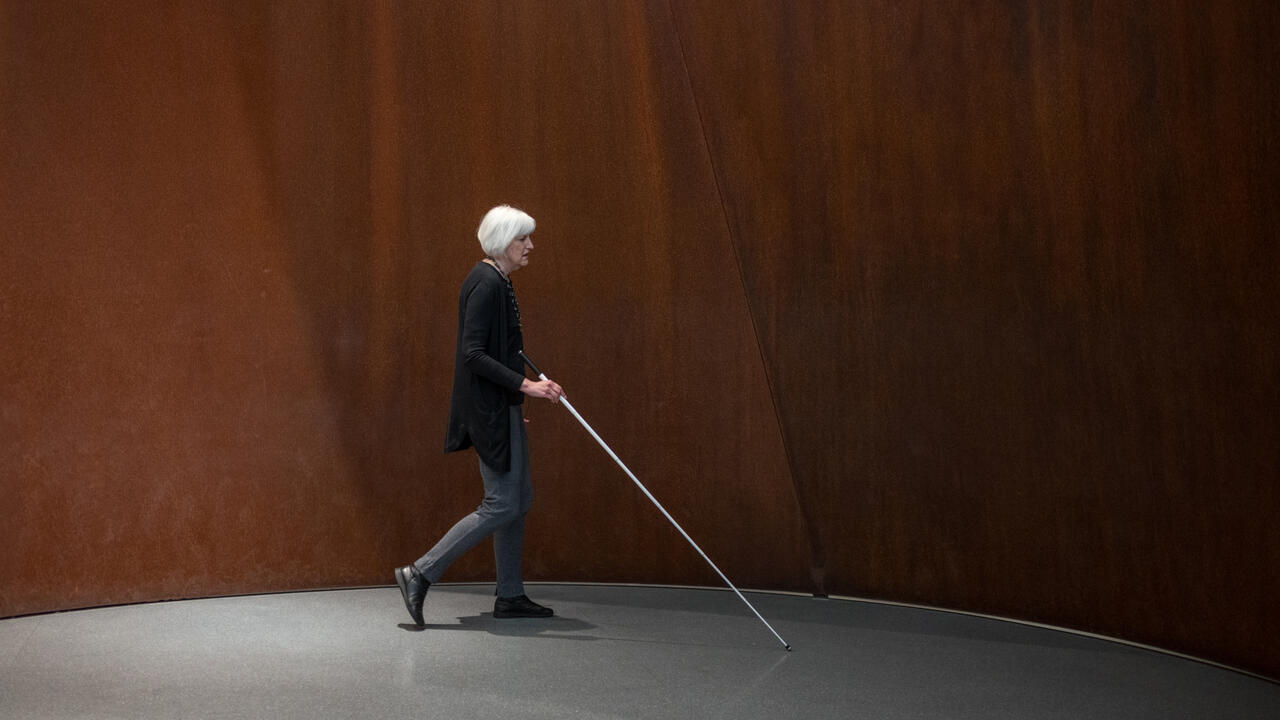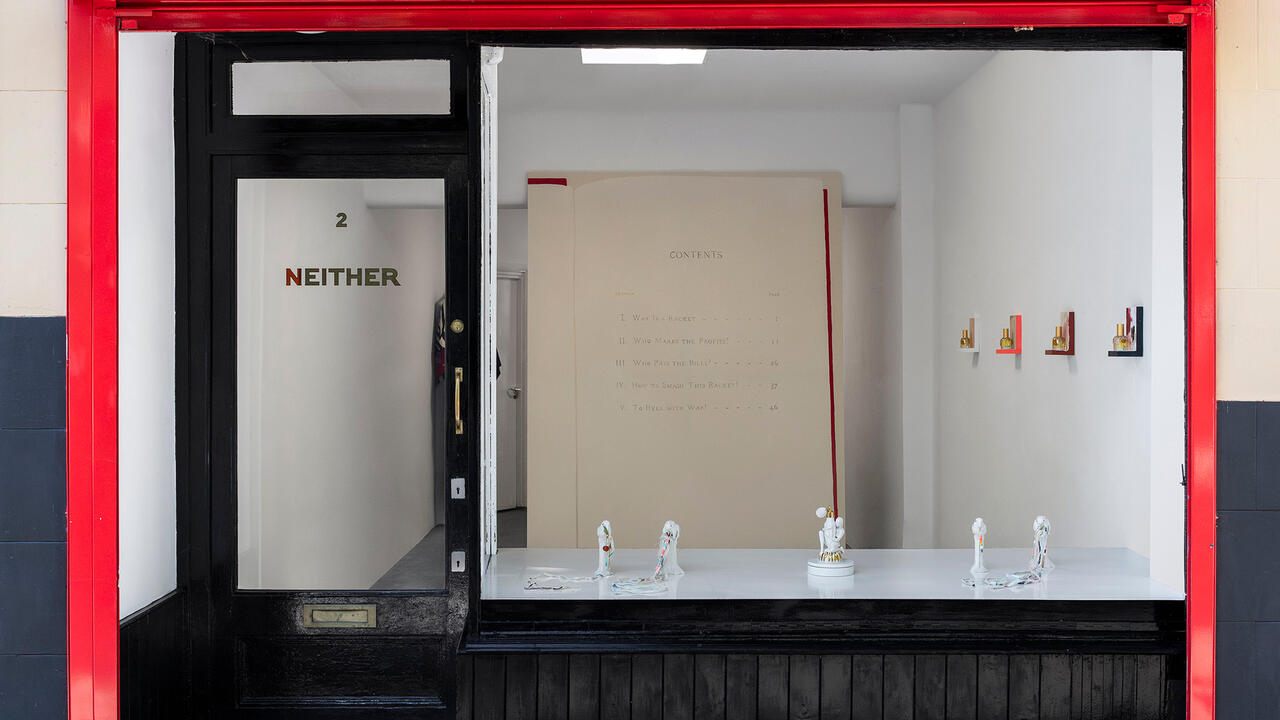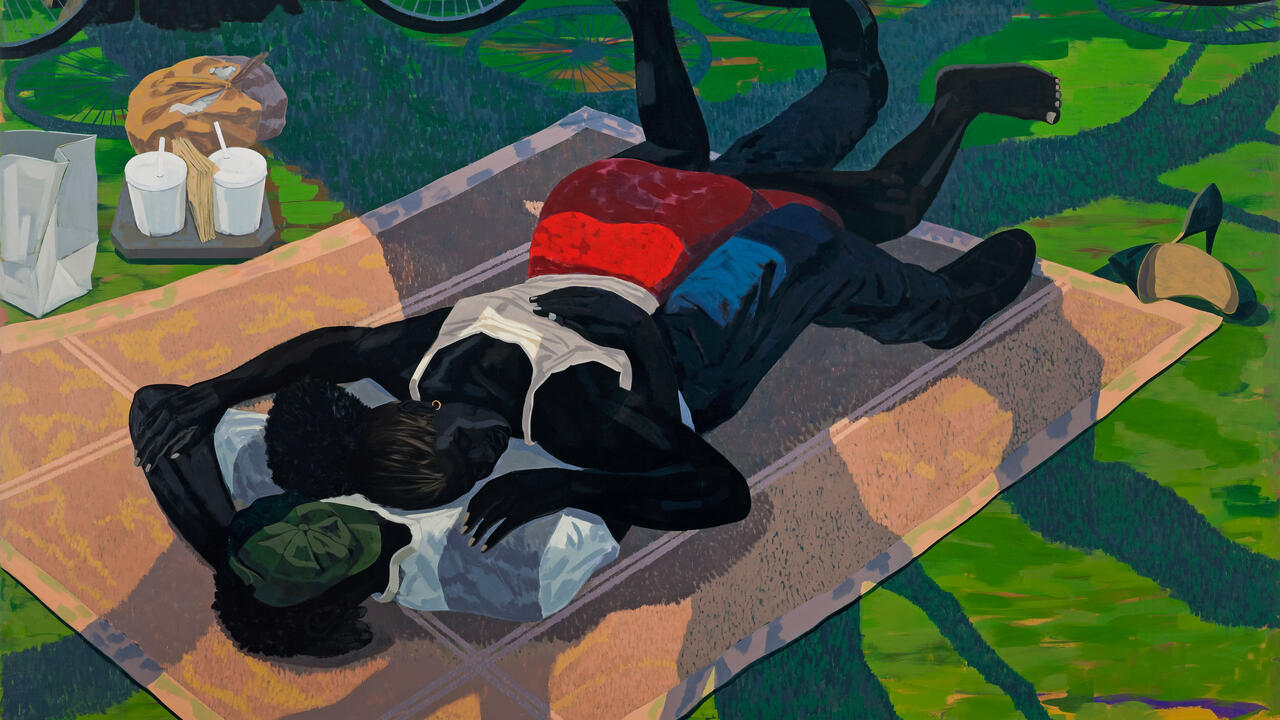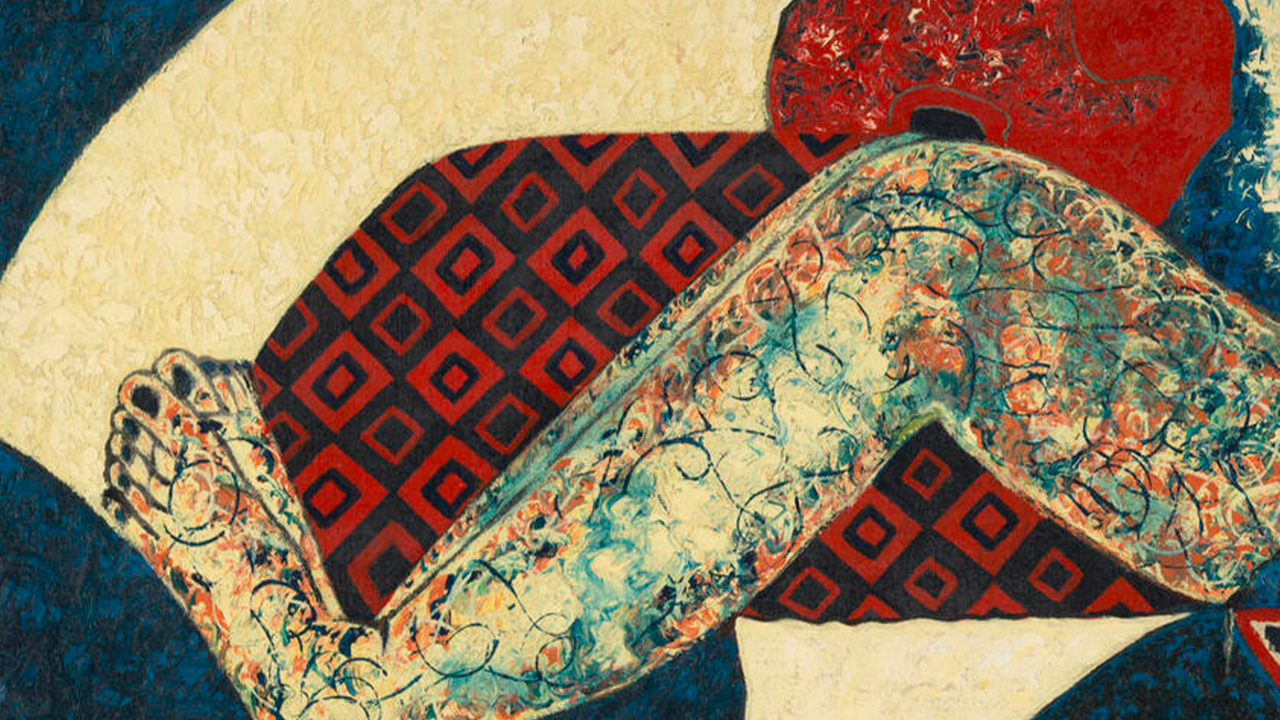What You See
Visibility, identity and black people on Mars – Kerry James Marshall in conversation with Ellen Mara De Wachter
Visibility, identity and black people on Mars – Kerry James Marshall in conversation with Ellen Mara De Wachter

Kerry James Marshall, born in 1955 in Birmingham, Alabama, was brought up in Los Angeles before moving to Chicago, where he now lives and works. His practice – which includes painting, photography and video – engages with African-American histories, from the slave trade to the Black Nationalist movement, as well as with more intimate stories of specific individuals. Commemoration is a recurring theme, with a key series of paintings dedicated to ‘Lost Boys’: young men killed or abandoned by various social systems. His oeuvre addresses the dearth of representations of the black body in art history and mainstream culture, and aims to redress this ‘lack in the image bank’. Marshall’s works develop a nuanced system in which each of the many different blacks he uses gains its own visual definition and meaning. Ellen Mara De Wachter spoke to Marshall on the occasion of his current retrospective, ‘Painting and Other Stuff’, at M_HKA, Antwerp, the largest presentation of his work to date.
Ellen Mara De Wachter I was particularly struck by your collages: Yellow Quarters (1979), which depicts a man lying on the ground with a house on the horizon, and the two Untitled (Nude) works from 1982 of naked black females. The way you’ve torn the paper is very painterly. Did you decide to show these works now because you just recently came to a new understanding about collage, or because ‘Painting and Other Stuff’ is such a comprehensive exhibition?
Kerry James Marshall It certainly is a big show! It attempts to outline the pathway of my production. The early drawings, like Skull Drawing (1970–71), and the early paintings and collages are all really foundational works that got me to the place where I am today.
It’s not as apparent in a lot of the early work, but I already had kind of a collage sensibility. When I started making collages – and they were so small at first – people used to say: ‘Oh, these would be great as studies for a big painting.’ But I really wasn’t interested in that because the collage is its own thing. Part of the challenge that I set for myself was to make paintings that were collage-like but didn’t start from collages. Some of that remains in a number of the works here. There’s a period in which I was making paintings that really look like they were constructed from fragments of things.
EMDW Even something like your recent three colours trilogy – Red(If They Come in the Morning) (2011), Black and Green (both 2012) – has that collage sensibility, because I can’t read it all at once, I have to skim across and go in, out, back, forth. In Untitled (Nude), it’s like the torn paper is all kinds of different blacks but none of them seems to be taken from photos of flesh, just from backgrounds. To create the figure you’ve used what is probably a night sky or an airport or an advertisement for a drink.
KJM But then you find out that those blacks have colour in them, too. Some of them are blue, some are green, some are red or brown; all of that colour in those blacks became really important to me while I was making collages.
EMDW In your painting Believed to be a Portrait of David Walker (Circa 1830) (2009), I can read all those different blacks and see the intimate, painterly knowledge you need to have of the pigments you’re mixing in order to create them.
KJM Which is hard to do. When I started painting these black figures against black backgrounds in 1980, I was trying to figure out how to create this distinction between the image and the ground, but still preserve the essential blackness of the whole thing. Which is almost like the way Ad Reinhardt’s paintings work; there’s a lot of difference in them but when you first encounter one of his black paintings, it just seems to be a solid black, flat surface.

EMDW What about the factual sources in your paintings? Of the works that comprise the aforementioned triptych – one of which is predominantly red, one black and one green, comprising the colours of the Pan-African flag – I believe you said that Black depicts the side of a school in Chicago.
KJM Malcolm X College in Chicago flies three flags in front of the school: the American flag, the City of Chicago flag and the Black Nationalist flag – the red, black and green. It’s that space in which those flags are flying.
EMDW Are the things that are happening in black culture in the us right now inspiring your current work? I’m thinking of Jay Z’s ‘Picasso Baby’ video or Kanye West’s performance at Art Basel (both 2013)?
KJM That doesn’t interest me because it’s just entertainment.
EMDW But with the Jay Z video, one could say he involved so many interesting artists – Fred Wilson, Lorna Simpson and Rashid Johnson, for example – that perhaps it was more than entertainment and a way of giving greater visibility to black artists? And whether that’s simply a power play or whether it also has an impact on the visibility of black culture in a fine art context, might be an issue. Do you see any benefit in this kind of art-world participation in mainstream culture or is it just a strategy?
KJM My first response is that it’s a publicity stunt because it’s not clear what the benefit of it would be. On the one hand, Jay Z is making a lot of money. He’s buying Picassos, right? That’s what rich people do. And he just happens to have recently come into some kind of consciousness that he can participate in the art world as well, so what he buys gets some attention because Jay Z bought it. To the degree that it encourages other wealthy black people to buy work by African-American artists, that has some value because the art world depends on markets, just like anything else.
In order for African-American artists to achieve any kind of independence – the ability to do what they want to do as opposed to what they think they need to do to be viable in the marketplace – you really do need a large enough group of black folks who are willing to pay for things that mainstream collectors won’t pay for. When you achieve an independent economic foundation like that, then you can do anything. So if that’s the outcome of this kind of thing then that’s all good because it fuels and funds a thing called an avant-garde.
EMDW It’s about collectivity, isn’t it? It always has to be.
KJM Right. In order to go against the grain you have to have a solid support structure. At the moment, that doesn’t exist for black artists because most of their work is not bought by black people. That’s just the reality. Even where there are black people who have a lot of money, you don’t have a lot them with the knowledge or real interest in being part of what you call the contemporary art world, because that didn’t emerge from their culture. You’re talking about trying to build a culture of consumption in a particular art world that doesn’t really exist.

But that’s also a consequence of the fact that the black population in the us is capital-poor, in the real economic sense. So we don’t drive any of the markets, especially of individual artists. In some cases, you could argue we don’t even drive the markets in the music industry, where black people are more present and have been for generations. All of those hip-hop artists who have been successful are only successful on some levels because white kids spend money on those CDs and go to those concerts; it’s not because there are whole lots of black folks going to those concerts, because they just don’t have the money to support that.
EMDW You have made several works that deal with young black men, and the killings, disenfranchisement and injustices they suffer. Your ‘Lost Boys’ series features portraits of black boys who you’ve described as ‘lost in the ghetto, lost in public housing, lost in joblessness, and lost in literacy’. Wake (2003) is a work comprising 20 photographs of black men and women, including one of yourself as a young man, who are stand-ins for the first Africans sold into slavery at the Jamestown Settlement in 1619. Are more recent events – such as the killing of Trayvon Martin in 2012 – something you would tap into for inspiration, or are you more interested in historic figures as symbols of the oppression of black Americans?
KJM I wouldn’t do anything around Martin’s murder because, really, the ‘Lost Boys’ piece was already my comment on that.
EMDW Only it keeps happening ...
KJM Again and again. There’s a way in which making work that responds to current events is just a means of venting, or being able to scream: ‘This thing hurts!’ But all of the marches, all of the protests, all of the celebrities wearing hoodies saying, ‘I am Trayvon Martin’ – that just makes people feel good in the moment because it makes them feel they did something in a circumstance where they’re powerless otherwise. But what they never address are the roots of that powerlessness.
Part of the reason why I make works across the span of history – from the David Walker portrait up to, say, Red (If They Come in the Morning), which references the title of Angela Davis’s 1971 book –is because I’m interested in the precipitating events that cause these things to happen over time and in succession. In the case of Martin and the idea of racial profiling, the question is not really whether there’s racism in society that causes people to act the way that George Zimmerman did when he shot him; the real question is why Martin was vulnerable in the first place.
EMDW We have to go back to the sources.
KJM We have to ask: Why are black people largely economically, socially, psychologically and politically vulnerable? If you want to transform the circumstances of black people writ large, then you have to start looking at the implications of those originating events and how black people got in the position they’re in.
EMDW In what way do you think art can effect change in that understanding? Is it a matter of consciousness-raising? Or is there an actual political or revolutionary potential in the images you make and how they’re disseminated? How do you get beyond the confines of the museum or the magazines or the discussions around art school tables and into the world?

KJM There are two ways to think about it. One is to consider what the museum represents. When I came here this morning there was a group of about 40 seven and eight year olds touring the museum. If there are black kids in those groups and they only see white people in these pictures then they will be conditioned, like a lot of us are, to expect that you only see white people in art work, and especially art work that is supposed to be ‘the best’.
EMDW So, having works in public collections that are about black people, or show black people, is a big start.
KJM It’s a big start if they come to museums and encounter images thathave black figures in them on a regular basis. Then they don’t grow up with this assumption that they don’t belong in there. The investment that people make in places like this museum – the building, the structure – matters, and so this is a transformative arena. Its power extends beyond the museum itself because of the encounters that somebody in their formative years will have with what they see in a place like this. That leaves an indelible impression.
Then there are also the images you see within other kinds of visual production. If I pick up European Vogue, let’s say, or W magazine,I could turn 40 pages before I see a picture of somebody who is not white. So you say: ‘The preferred image is this woman, this woman represents what is beautiful, what is sophisticated.’ So that means the people who are producing those images prefer them. White people like to see themselves and they are comfortable with themselves as representative of what’s beautiful and advanced in the world. But if I pick up these magazines and I say that this is also my preferred image, how I define beauty, then there’s something wrong with that. Because the image of a black figure is not equal, it can never be used as a substitute for what’s beautiful. When it’s present, it’s present as an exception.
EMDW Yes, what most people are presented with through advertising and much of culture is a limited characterization of beauty.
KJM Absolutely. But that limited conception of beauty is an aspirational one that most people are conditioned to respond to. I think human beings have always been in competition with each other. And if there’s no sense that everybody has a shot at being on the top at some point, then there are people or populations who are always on the bottom. If you see yourself as a part of the population that always ends up on the bottom, then you have a psychological problem that you have to overcome.
So our problem – and this is the problem of black folks in America and the problem with black folks worldwide, I would argue – is that we’ve constructed this narrative in which the expression of white desire for images of white beauty is problematic; racist, even, insofar as the white population is seen to be dominant in the world because of the way it has projected its power and its influence over other people, dominating, colonizing and exploiting. So now it has become problematic for people of colour to express any real desire for their own ideals of beauty.
EMDW Which is much more complex than the simple picture that Vogue paints.
KJM But it’s not such a simple picture that Vogue paints, because every other magazine paints the same picture. Even in the art world, images are an index of power. And if you aspire to power in any way then you should be producing images that compete for power and dominance, the same way everybody else is producing them. The movie industry is another place where this index of power is manifested. If you take the series of Harry Potter films (2001–11), for example, or all these sword-and-sorcery movies, all the fantasies: who kills dragons, who does magic, who talks with animals and travels through time? Who does that? White kids do magic! To me, this is not benign.
How can you live in a world that’s structured so that your place in it is primarily the domain of entertainment and service? You have to examine the psychology of being in an environment where you’re only able to appreciate the accomplishments of other people. You can like a singer like Jay Z or Beyoncé, and black people have been liked for doing those things throughout history. Thomas Jefferson wrote in 1781 in his Notes on the State of Virginia that he thought: yes, these black people have great talent for making music and singing; maybe they even have more talent at it than white people.
But in the domain of intellectual achievement, the question will end up being: can black people get to Mars if white people don’t take them there? That’s a really important question, because it says something about who shapes the future. This is purely about the position black people occupy in the world. In the competition for global development now, India is a surging force. But even as they are surging they’re also economically and technologically behind, because they’re coming out of a period when they were colonized and dominated by other people.
EMDW It’s hard to imagine a scenario where they catch up or get ahead without terrible things happening, without massacres.
KJM Right, because that’s how everybody else, the leading world powers, got ahead.
EMDW What kind of impact do you think your show is going to have here in Belgium, given the country’s relatively recent colonial past, with Congolese independence only realised in 1960? What kind of different readings do you think that might generate? How do you feel about your works being interpreted in all kinds of ways related to black history?
KJM I think the primary thing my work does is establish a black presence. On some level that’s really all you can expect it to do. It’s a physical presence, because there are figures in the paintings; and it’s a kind of philosophical or historical presence in terms of those subject matters that have to be addressed. I don’t expect art works to do any more than show you something that you might not have seen otherwise, to make you think in a new frame of reference.
EMDW Is figuration your preferred mode because it can communicate more directly to people who are used to reading pictures of people presented to them by the mass media? Is there a fundamentally stronger potential in using figuration because it’s what we all know?
KJM My provocative answer would be yes, because figuration is more important than abstraction. It’s more necessary, because we live in a world in which image production is the dominant activity and the quantity of images you see really does matter. There needs to be a critical mass of black figures in paintings; period. End of story. Abstraction – from the purely decorative to the brutally austere – is more easily commodified than figurative work. It travels through the marketplace a lot more smoothly than figurative work does. But I think it’s less necessary. I think black people should always be producing figurative work because it’s naïve to believe that the art world is not a part of the bigger world, and there are political implications to everything that goes on in this domain. If you don’t think that’s the case then you’re somehow deluding yourself. As long as white figure representation outnumbers black figure representation there’s a need to produce more black figure representation; it’s just that simple.
‘Painting and Other Stuff’ is at M_HKA, Antwerp, Belgium, until 2 February. It then travels to Kunsthal Charlottenborg, Copenhagen, Denmark, from 27 February to 4 May; Fundació Antoni Tàpies, Barcelona, Spain (10 June – 26 October); and Museo Nacional Centro de Arte Reina Sofía, Madrid, Spain (12 June – 26 October).






















